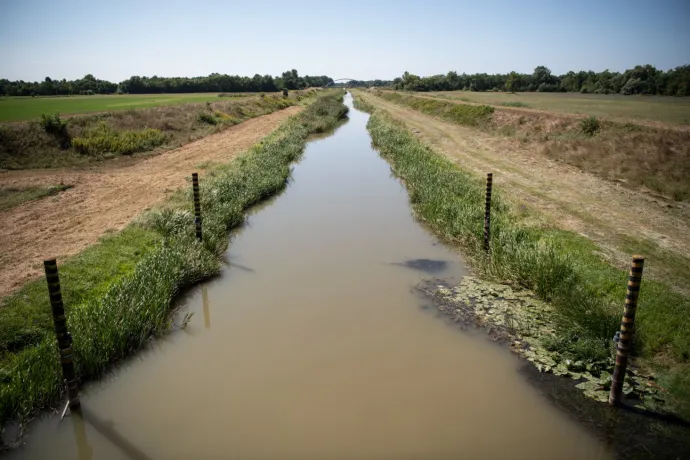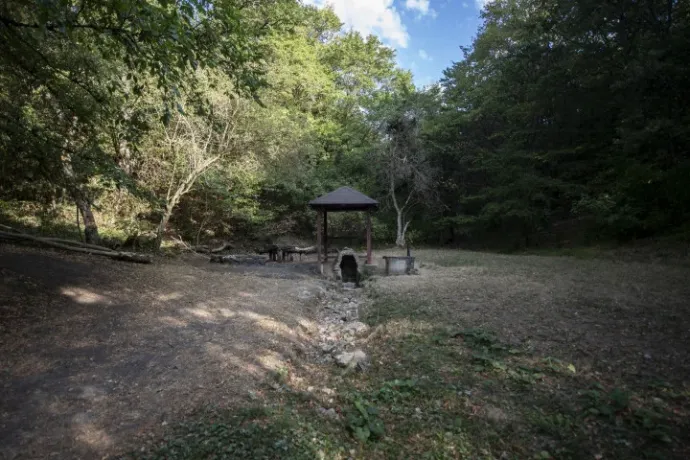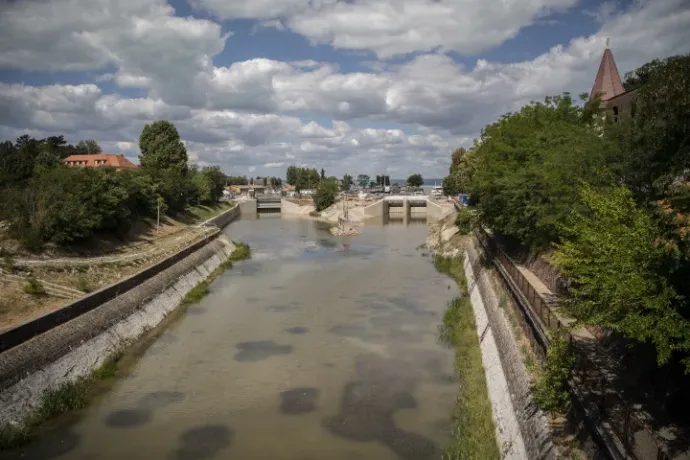
This article was originally published on Telex in August at the height of this year's draught. We are republishing it in Engish now as the problems described in it are far from being solved, and we believe it is important to look back at the year behind to see what we can learn from it as it relates to the future.The water is nice and clear, and its level is only a little lower than usual at this time of year, and there is no apparent threat of desiccation. So what is the problem around Lake Balaton? – we asked some experts this summer. First of all, the lack of rain, development projects harmful to nature, the outdated infrastructure of the 1980s and 1990s, and the unpredictability of climate change. And a whole lot more.
In the Koloska Valley, a few kilometres above Lake Balaton, a drinking fountain is decorated with a green frog sitting in a reed bed. No water flows from the well, nor from the spring in front of it, and the artificial lake bed in front of it is bone dry. The only indication of the stream that flowed from here not so long ago is that the vegetation is somewhat deeper and denser than a few metres away. It is a weekday morning, all is quiet and still. A glance at the dried tree standing statuesque a few metres away is enough for one to feel as if they are in an apocalyptic vision. Only this is not the future, but August 2022, somewhere above Balatonfüred.
Királykút (meaning 'The King's Well), a few kilometres away in Felsőörs, is a similarly depressing sight, although its water – not a drop of which is left to show – was legendarily clear, named after King Matthias, who, according to legend, was happy to sip from it.

The sight of two dried-up springs on Lake Balaton is a sad one but not surprising: some estimates suggest that roughly two bathtubs of water per square metre are missing from land and water bodies in almost every part of the country. The water level of Lake Balaton is also visibly lower, but its waters are as clean as usual, with no signs of algal blooms – so far. The drying up of Lake Velence and Lake Fertő is becoming an increasingly threatening scare, but until the second week of August, the only concern for holidaymakers on Lake Balaton is the water level, otherwise, it's as usual. We have checked if this is true.
The worst condition in the past 100 years
First, a bit of hydrogeography: the shallow, 3.7-metre-deep Lake Balaton has a catchment area of about 5,000 square kilometres, is fed by 90 different watercourses, and as every Hungarian has learned at school, its water supply comes largely from the River Zala. And, of course the rain plays a part as well, which has been absent from the lake and its surroundings for months, while the weeks-long heatwave has also caused the lake's water to evaporate intensively.
"If there is no precipitation in the catchment area, it will impact Lake Balaton. And it's true that fifty to sixty percent of its water is replaced by the Zala, but that too is brought by rain."
– explains Viktor Tóth, a senior research fellow at the Balaton Limnological Research Institute.
This summer, Hungary was experiencing the worst drought in living memory. Record low water levels were being recorded on several of our rivers, some of which were almost dry enough to cross on foot, but agriculture was also severely affected by the drought. Grasslands were burning out, crop yields were low and we were also seeing more and more destructive fires. In a series of articles this summer, we looked at the effects of drought, as well as ways to adapt or prevent it. This was the fifth piece in our series.
It is not an exaggeration to say that the water balance of Lake Balaton is currently in the worst condition in the past 100 years (water balance is roughly the ratio of input to output, i.e. how much water flows into the lake, falls on its surface; and how much is removed by evaporation, water discharge and the Sió canal). In response to our enquiry, the National Water Directorate General wrote to us that reliable, accepted water balance data on Lake Balaton have been available on a monthly basis since 1921. "A review of these shows that the period between January-July 2022 is the lowest since 1921, which represents a strong negative extreme. The last comparable January-July low (-149 ‘lake mm’) was in 2012 (1 ‘lake mm’ of water column on the surface of Lake Balaton corresponds to about 600,000 cubic metres of water, and the total means a 14.9 cm shortfall compared to the long-term average. Or we could say that 89 400,000 cubic metres of water would be needed to reach the long-term average.)

One of the main reasons for this is that
"from January to the end of July, the catchment area of the lake received 23% less rainfall than the long-term average (1991-2020). The catchment was already significantly drier than usual last year, so water shortages have continued to accumulate this year."
– the water management agency says. Because not enough precipitation fell, the water yields of watercourses – the streams we mentioned, the brooks and the River Zala – have been severely reduced. Currently, the water yields in the Zala River, the main surface feeder of Lake Balaton, near its mouth, are only 25-30 percent of what is usual at this time of year.
As we saw at the two wells mentioned earlier, some intermittent small watercourses in the catchment have dried up. You can still see some water in most streams, but much less than usual. It is also interesting to note how dry the landscape is on the eastern side of the lake, while in the western part, especially around the waterlogged area of Kis-Balaton, there are patches of green grass and flowers sprouting.
It won't get any better than this
A much lower water level than the current one has been measured before in the past 100 years (but it has also been half a metre higher, too), and the image of the drought between 2000 and 2004, when families with small children used to go bathing on the sandbanks rising from the lake on the southern shore, is still vivid in collective memory. The average water level of Lake Balaton was 78 centimetres on 9 August this year, the National Water Directorate General wrote in response to our enquiry, which predicted almost exactly the same in its spring forecast. The average water level is calculated on the basis of data from the water level measuring stations at Balatonakali and at the Tihany ferry, and after the aforementioned “sandbank summer”, on 19-20 October 2003, a value 55 centimetres lower than this – 23 centimetres – was recorded. "This means that the current average water level is low, but not at all abnormal," the National Water Directorate General wrote in response to our question.

Are we heading for summers with sandbanks? – we asked Viktor Tóth and his colleagues. Viktor Tóth said that by the second week of August we were at about the same water level as in 2012, and the biggest concern is that we are likely to see more and more frequent droughts like this year's.
"To the best of my knowledge, there is no climate scenario that suggests that summers will be wetter and colder in the future, so with little exaggeration, this summer has been one of the coldest and wettest summers in the rest of our lifetime."
– he says painting an unpromising picture of the future.
It's unpredictable what climate change will do to Lake Balaton
"Water management experts can estimate the water level of Lake Balaton a few months in advance based on the annual water level fluctuations of the past decades. There have been three droughts in the past 20 years, so these experiences give us a rough idea of what will happen to Lake Balaton next year. By contrast, we have no experience with climate change: it is very difficult to predict where a global-scale process will be in five or fifty years' time, which is why climate scenarios are so wide-ranging," he explains.
– The larger an ecosystem, the more unpredictable its behaviour. It's easier to describe the biological connections of a tiny pond based on two or three dozen measurements, whereas with Lake Balaton it's impossible to do so even with a thousand pieces of data" he says. In an interview in spring, he outlined a pessimistic scenario that he hopes will not materialise, saying that in 15 years Lake Balaton could be unsuitable for bathing because its water quality will be so degraded, and by 2050 it could be completely dry, something that has never happened before. The other problem, apart from the low rainfall, is that the water level of the lake is kept too high and too stable for tourism and economic reasons, and it is not good for nature.
"Theoretically, it could happen, but it would require really destructive, really mindless behaviour in the meantime. And if we behave like this, in ten years' time we won't even be giving climate change a chance," he says.
He sees that the same thing has been happening concerning the climate crisis as in the opening scenes of pretentious Hollywood movies: a researcher signals the approach of a threat, but the leaders don't take it seriously. "For 40 years, scientists have been warning that water will be the most important resource that countries will fight over. This warning has been ignored by most governments, but some, like Norway, the Netherlands and Iceland, have taken the scientists' advice seriously and are preparing for it in earnest. Others have only short-term goals in mind."

Modernization is needed, but not with housing estates made from concrete and glass
Is this true around Lake Balaton as well? The key word here is modernisation, but it is of a very different nature from what can currently be seen when travelling around the lake and is closer to the destruction of nature. The big algal bloom in 2019 was a strong warning to experts that the lake's monitoring system needed to be modernised. This may well become reality if the current crisis doesn't sweep it away.
A further problem is that the infrastructure around Lake Balaton still in place is from the 1980s and 1990s: the drainage and wastewater treatment systems, for example, are completely outdated.
According to Viktor Tóth, "we'd have to make up for decades of backwardness in order to present a tourist environment with modern water management".
Instead of the mushrooming concrete and glass housing estates near the water, what Lake Balaton needs is useful, large-scale development of the infrastructure. However, the municipalities around the lake cannot afford the costs, and such investments are not spectacular, only useful. When the Zalaegerszeg sewage treatment plant was built at the end of the 1970s, it had a major impact on the water quality of the Zala river and, indirectly, on the algae growth in Lake Balaton. Another important milestone was the completion of the drainage canal around the Balaton in the 1980s, which meant that treated wastewater from the treatment systems was no longer sent back into the lake.
"Water management experts know what should be done. Of course, the beneficial effect will not be felt immediately, but in about ten years, so such developments will not bring benefits between two elections" – Viktor Tóth alludes to the danger of political short-sightedness regarding the future of Lake Balaton.
For more quick, accurate, and impartial news from and about Hungary, subscribe to the Telex English newsletter!